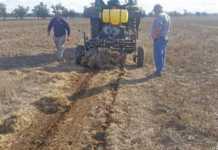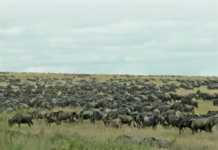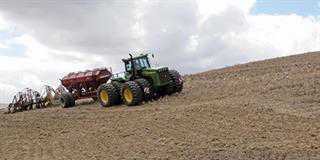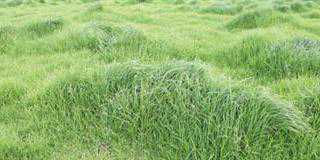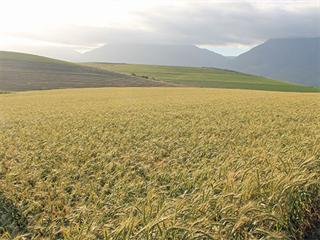
It is late afternoon and a large herd of Jersey cows amble towards the milking parlour of CD du Toit’s farm at the foot of the Langeberg Mountains near Riversdale. Not far away on the same farm are 1 500 Dohne Merino ewes and 1 550 ostriches reared for slaughter.
Considering the quantity and quality of livestock on the farm, it comes as a surprise to hear that CD and his brother Erhardt are finalists in Grain SA’s 2013 Producer of the Year competition. The accolade is testimony to their skills at diversification and careful planning.
Two brothers, two regions
CD started farming in Riversdale in 1992 after selling land he inherited near Heidelberg. The brothers then joined up
as a team in 2003 when Erhardt bought a farm near Napier in the Overberg. They called their combined operation Toit Broers Boerdery; CD is responsible for farming activities in the Riversdale area, while Erhardt manages the farming interests in Napier.
The Riversdale operation comprises 820ha arable land, of which 125ha is leased, and 620ha veld, of which 125ha is leased. In Napier, they own 730ha arable land and 130ha veld, with an additional 405ha leased for grain production. CD explains that they decided to farm in two diverse areas in order to capitalise on the production conditions offered in each.
“The farm in Riversdale is at the foot of the Langeberg Mountains and the area receives 650mm of rain annually, of which up to 55% is during summer. As a result, the veld has a high carrying capacity and is ideal for sheep farming.” During winter, the brothers run sheep either in the veld or on pasture, reducing input costs as feed seldom has to be bought.
“The farm near Napier receives between 480mm and 500mm, mostly in winter, making it ideal for winter grain,” he continues.
Here, the main focus is crop farming. The brothers employ conservation farming, using a continuous cropping management strategy by planting a different crop each year in a four-year rotation cycle on their own land. “We plant wheat, followed by canola, then wheat again and in the fourth year, lupins. Then we start over again with wheat,” explains CD.
“The leased land is in a long 10-year rotation cycle aimed at preventing root diseases and controlling weeds. We grow wheat, barley and canola in rotation in that order for six years, then establish lucerne for a four-year period for the owner to graze his sheep.” They follow a similar system on the Riversdale farm, rotating cash crops on a three-year basis (wheat–canola–wheat) before establishing lucerne for four years.
All livestock are kept at Riversdale. “The ewes lamb three times in two years, so we strive for a 150% to 160% weaning rate per year, and a 110% weaning rate per lambing season,” says CD.

CD and Erhardt du Toit. Photo courtesy of CDdu toit
Conservation farming
According to CD, one of the main pillars of conservation farming – ultimately aimed at conserving soil and soil moisture – is crop rotation. “If we produce grain crops for too many years in succession, it becomes difficult to control grass in the lands because of the limited options for chemical control of grasses in grain crops,” he explains. “So growing grain crops in rotation with broadleaf crops gives us the opportunity to control grass more effectively.”
Another pillar is minimum tillage and retaining crop residue in and on the soil. This provides cover that helps retain soil moisture while also building up the organic matter content. The brothers perform one operation at planting: applying fertiliser and planting seed into the previous year’s crop residue in a single pass. This year, they have planted 800ha of wheat, mainly SST 056 and SST 027 varieties; 230ha of barley, mainly S6, Erica and Nemesia; and 470ha of canola, mainly Hyola 575CL, Hyola 571CL, Hyola 555TT and Pioneer’s 44Y86.
Canola cultivars are selected on the results of recent annual trials. In addition, 180ha lupins are grown for seed production and as additional feed for the sheep and ostriches. “We stick to a tried-and-trusted agriculture system,” says CD. “Many farmers in this area have been following a production plan aimed at retaining soil moisture and this has helped considerably. Conservation farming practices also greatly reduce the risk that crop farmers face in winter due to drought.”
Profits
CD has been using conservation farming principles for about two decades. The organic matter and humus content of the soil has improved so much that the risk of suffering crop losses in extended dry periods in winter is considerably lower than before. “The soil is far healthier and better able to retain moisture because we retain crop residue on the land. We bale nothing and practise minimum tillage,” he explains.
CD emphasises that he and Erhardt take a long-term view of profitability versus crop yield. When the need arises, they invest in improving their soil by doing the necessary correction or changing their system, even if they know they will not reap the benefits immediately.
Pest management
The brothers’ conservation practices extend to pest control too. “We’ve been moving away from spraying insects,” explains CD. “We use seed treatment instead to minimise post-emergence spraying. After planting treated wheat seed on the Riversdale farm for three years, we found that we no longer had any problem with aphids.” The brothers use Bayer’s Gaucho, a systemic, flowable insecticide and fungicide seed treatment, and similar generic products.
“Using our own machine allows us to treat wheat, barley, lupins and canola seed at the same time as we apply trace elements,” says CD. They control the main pests and diseases affecting wheat and barley – net blotch and bacterial leaf streak – by a preventative spraying programme designed by a consultant.
“We start by spraying a strobilurin-based fungicide alternated with other products for broad-spectrum disease control such as Syngenta’s Artea or Bayer’s Duet. We spray two times per season on wheat and three times on barley,” explains CD.
During the growing season, the brothers put out snail pellets once or twice as needed. As with many other grain farmers in the province, they use crop rotation to control weeds. After each harvest in the rotation cycles, they alternately spray the lands with a glyphosate-based broad-spectrum systemic herbicide and Syngenta’s Gramoxone with paraquat dichloride, a non-selective herbicide.
This avoids herbicide resistance developing in weeds. Before planting wheat and barley, they spray metribuzin or trifluralin on the land to kill off grasses that might have sprouted. During the lucerne phase, they use the time to eradicate grasses by spraying Gramoxone and metribuzin before they can set seed.
A reason for including canola in the cycle is to control grass. As canola is a broadleaf crop and wheat and barley are grain crops, CD and Erhardt can use different herbicides when planting canola. This prevents weeds from building a resistance to a specific type of herbicide. Planting triazine-resistant canola enables them to spray atrazine to kill off ryegrass growing in the canola.
Fertilisation
The brothers use the Albrecht system of soil mineral balancing, conducting soil analyses every three years. Apart from this, the normal fertiliser programme on barley and wheat starts with applying between 80kg/ ha and 100kg/ ha mono-ammonium phosphate (MAP11-52-0) at planting, together with 20kg/ha and 30kg/ha nitrogen as urea on the Riversdale and Napier farms respectively. Applying potassium sulphate (K2SO4) at planting addresses the problem of potassium deficiency in the soil.
“On the Riversdale farm, we seldom apply top dressing, but in Napier we apply two 20kg/ha urea top dressings. Included in the dressings are humates and trace elements such as manganese, boron, copper, zinc and molybdenum,” adds CD.
Yield has been exceptional in the last two years due to favourable weather conditions and good rainfall.
“In 2011 and 2012,
Our wheat and barley yield in Napier averaged around 4,8t/ha, but the long-term average is between 3,5t/ha and
4,5t/ha. In Riversdale, the average yield for wheat and barley was between 3t/ha and 4t/ha. On canola we got between 1,7t/ha and 2,3t/ha in Napier, and between 1,7t/ha and 2t/ha in Riversdale.”
Good soil
CD sees the need to reduce input costs as one of the greatest challenges facing grain farmers in the province. But he explains that he and Erhardt have been able to save on fertiliser because of the general improvement in the health of their soils over the past 10 years due to conservation farming.
“This has not been a good year for us. It has been dry and when the rain did fall, it was never at the right time. If we were not farming according to conservation agriculture principles that focus on improving soil moisture, we wouldn’t have had anything to harvest.”But their challenges are not limited to the farm and weather. South Africa’s grain farmers, are growing increasingly weary of competing with cheap grain imports.
“The problem is that the local wheat price doesn’t reflect the quality we produce,” explains CD. “The price we get is determined by the price paid for cheap, lower quality imported wheat that costs between R300/t and R500/t less from countries where farmers are given subsidies from the state. Until this problem is addressed, our only option is to market our wheat at the right time and price.”
Phone CD du Toit on 082 829 5928 or email [email protected].


